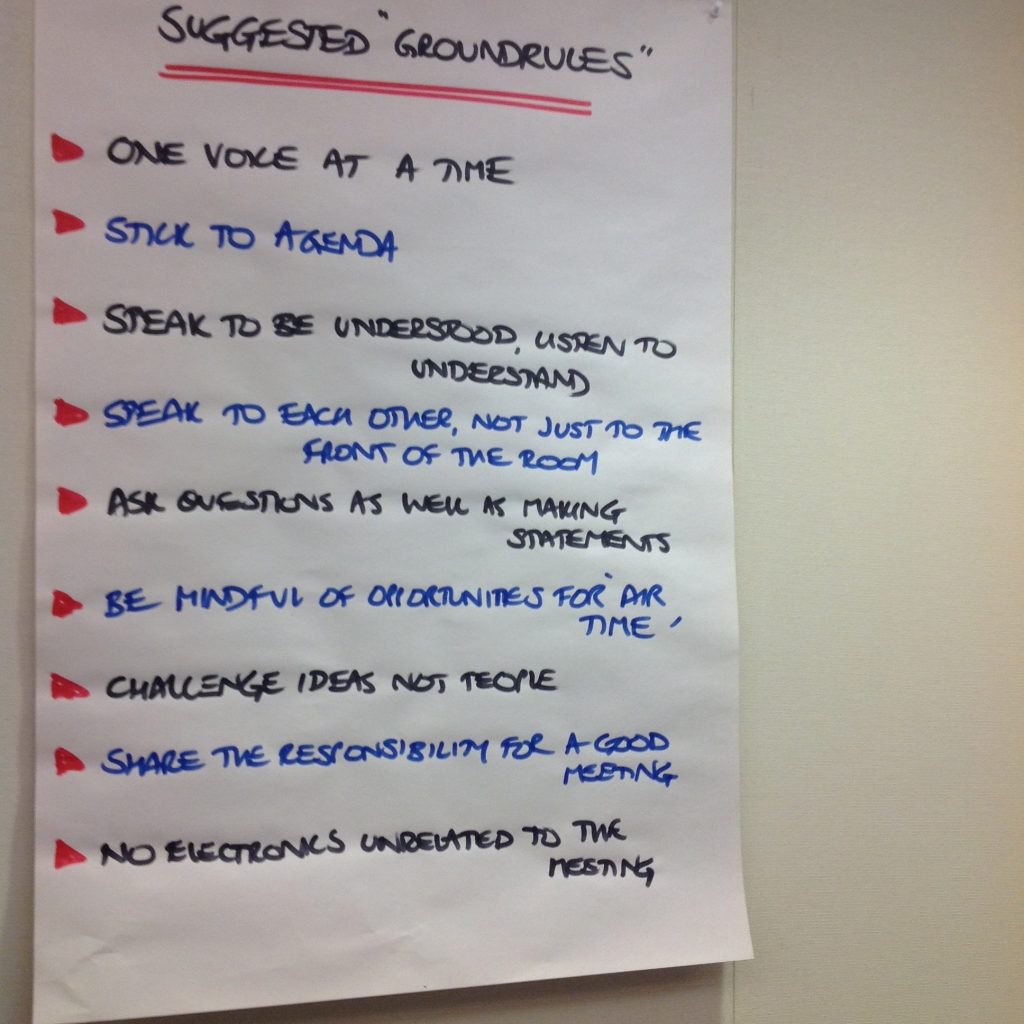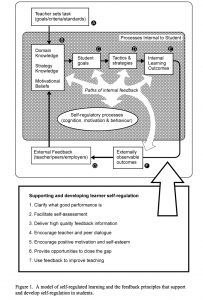In this post, I reflect on a 3-day course titled “Effective Group Facilitation” which I took last month and that was facilitated by Julian Griggs of Dovetail Consulting (see note 1). In some cases, my reflections will encompass aspects of the course which spanned the three days; in other cases, I will write about a single activity or idea. I’ll preface the reflections by saying this was an excellent course.
Effective and ineffective observable behaviours during meetings
Each participant generated a list of observable behaviours which we deem effective or ineffective and seen during meetings. Effective behaviours included: listening, taking turns speaking, being on time. Ineffective behaviours typically included: using digital devices, being late, interrupting. Julian’s provocative question was: Are these observable behaviours (actually) ineffective? Or, are we judging them to be ineffective? Could it be that, in some cases, a shouting match is exactly what we need to move a process forward?!
He cautioned: do not attribute motivation or intention (to a behaviour) too quickly! We must be aware of our own assumptions and be prepared to question and examine these.
Basic facilitation ≠ developmental facilitation
Basic facilitation builds dependency. Developmental facilitation builds self-reliance. From the handbook we received: “…in developmental facilitation, the facilitator is actively involved in helping the group learn to monitor compliance with its core values themselves” (p.C-6). I appreciated the articulation of this distinction.
Non-neutral facilitation
Many definitions of facilitation that I’ve encountered make some reference to the facilitator as someone who is “neutral” or “objective”. One thing I appreciated a lot about this course is that Julian acknowledged that, often, we are ‘non-neutral’ facilitators. He built time into this course for us to explore the challenges of this role (Section K of handbook).
As a non-neutral facilitator, how do we balance the need for impartiality with other demands? We worked through some helpful case studies to explore this (P.C-7 handbook).
And, for anyone wanting to read about general distinctions between facilitator, trainer, coach, mediator, chairperson, resource person, these links might be helpful (excellent table on P.C-5):
- Do You Know the Difference Between Training and Facilitation?
- A Comparison between Mediation and Facilitation
- 5 Big Differences Between Training and Facilitation
Activities/energizers that I particularly enjoyed
Portrait drawing
(a) first, we individually write a response to a question posed by facilitator [in this case, the question was: “What is the single most important thing I would like to learn/gain/strengthen from this course?”. (b) Look around the room, lock eyes with someone. Lock eyes! Take 20 seconds to draw that person. Then, move to that person. Share your response and drawing.
Where in the world?
[imaginary context: Community forum]
(a) designate a spot in the room, such as centre of room; (b) “if this is where we are right now, physically, find a spot in the room that represents a place in the world that is special to you. You’ll need to talk to one another to determine where you are.” (c) people move around and find a spot; (d) facilitator invites each person, one by one, to respond to “Why is the place important to you?”
Mirrors on your self
Imagine you have mirrors on your feet…Shine the mirrors on the ceiling (10 secs). Imagine you have mirrors on your hands…on your bottom…etc.
Twinkle fingers
To get a quick pulse from the group on an idea or other, first show the group how to do ‘twinkle fingers’ (participants hold out hands and move fingers as if they were playing a keyboard in one spot). If you want to find out from the group whether they agree with a particular decision (a light one), ask them to show their twinkle fingers.
Mindfulness (ends with 2 great questions)
I have used mindfulness in my teaching, but not in my facilitation. Julian guided us through a mindfulness activity but I don’t recall what it was. What I do remember were the two questions he ended with (these are great):
Imagine you’ve had a fabulous day (presumably, you’re imagining the end of the facilitated day),
- What have you done to make this happen (he came back to this later when inviting us to participate in role plays)?
- What have you NOT done to make this happen?
Ending simply and with energy
Instead of a drawn-out workshop end, everyone stands in a circle and holds hands. At the count of 3, everyone takes a step towards the middle of the circle, puts up hands and says “We’re done!”.
Interventions
We spent quite a bit of time on the morning of Day 2 on interventions. Doing this reflective writing has reminded me of the amazing resources that are in the handbook (see section G).
Simply put, an intervention is when you see something happening and decide to do something. Questions to ask myself as a facilitator:
- How do I know this behaviour (that I’m observing) is ineffective? (perhaps it’s my own ‘stuff’ …)
- Is this the right time to intervene?
- Do I have the skills to go here?
- Is it just me, or is this happening?
Ways to intervene:
- Change the structure (i.e, big group to small group)
- Change the content (get permission/agreement from the group)
- Reframe (i.e., “we’ve been struggling with X. Let’s look at the advantages of…” — help shift perspective)
Level of intervention can be low, moderate or high.
Tips on openings
(click on picture for list of good tips–please excuse the fuzzy picture)
Random nuggets
- As a facilitator, you are not responsible for the group’s success, you are responsible for helping the group be the most effective it can be. (Day 1)
- Ask both: “Is everyone clear on X (e.g. the learning outcomes)?” and “Is anyone not clear on X (e.g. the learning outcomes?”
- When using role plays in my teaching/facilitation, remind people not to overdo it.
Notes:
- This reflection is part of an assignment which I need to complete to get credit for the course.






